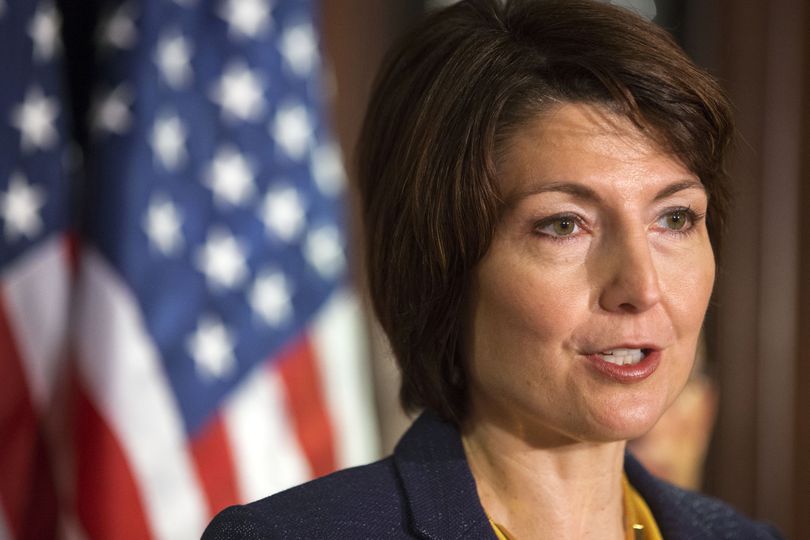A closer look at McMorris Rodgers town hall

Rep. Cathy McMorris Rodgers addressed a number of hot-button issues at a town hall held in Spokane on Tuesday night, beyond those covered in today’s Spokesman-Review story recapping the event.
The congresswoman was also asked about her support for the Paul Ryan budget, which the asker said cut benefits that several in her district relied upon. McMorris Rodgers was also asked about legislation passed recently to address the funds available for wildfire readiness, and whether that legislation was “disguised” as a law to benefit private logging companies. Another audience member asked McMorris Rodgers if she had a plan to reduce the cost of college tuition, in response to proposals from Democratic presidential hopeful Hillary Clinton.
Here are McMorris Rodgers’ responses to those questions, and whether those responses are backed by the facts.
QUESTION: Given that 1 in 5 citizens of your district relies upon food stamps, unemployment is at 30 percent higher than the national average, and 1 in 6 people live below the poverty level, contradictory to the needs of your district, you voted for a $2.71 million reduction in SNAP funding. Congresswoman, my question is given the current uncertain economic climate in Eastern Washington, how would any of these outcomes be better for your district?
MCMORRIS RODGERS: I don’t necessarily agree with the way you portrayed (the Paul Ryan budget) … I think we need to restructure some of these programs. In some cases, we need to send it back to the states … We didn’t cut anyone off of food stamps.
ANALYSIS: The House of Representatives passed several budget resolutions crafted by Wisconsin representative and former Vice Presidential candidate Paul Ryan between 2011 and 2013. McMorris Rodgers joined Republicans in their support for the budget resolutions, which were rejected by Democrats for cutting too much spending and not doing enough to raise revenue.
Food stamp reform did make its way to President Barack Obama’s desk in February 2014 as part of a long-term Farm Bill. The congresswoman is correct that the reforms did not kick people off the food stamp rolls. But it did recalculate the amount beneficiaries received by changing eligibility requirements.
Food stamp recipients can claim deductions on their monthly incomes by proving they pay for essentials, such as utilities and housing. Before the Farm Bill reforms, those receiving assistance for utilities and heating under another federal program automatically were eligible to receive food stamp benefits.
The new law changed the credit so that only households who received more than $20 in utility payment assistance from the federal government could earn an income deduction towards food stamp benefits. This cut about $8.6 billion in spending from food stamps between 2014 and 2024, according to the nonpartisan Congressional Budget Office. Food stamp spending during that time was projected to be $764 billion.
So, while the reforms did not cut people from the food stamp program, it did reduce the amount of assistance they were eligible to receive.
For more on this issue, see the Washington Post’s GovBeat blog.
QUESTION: The bill allows the federal government to let private logging companies into these forestlands … This bill has a provision about the wildfire prevention, but mostly it’s just to sell off federal lands to private companies, to deforest acres, and acres of old growth forest … It seems like if you’re saying it’s a wildfire prevention act, it seems like you’re just taking down the trees so there’s nothing left to burn.
MCMORRIS RODGERS: The legislation doesn’t allow for any selling off of federal forest land. What it does allow is for there to be more active management … 1 out of 3 acres on National Forest Service Lands - and we, the U.S. Forest Service owns nearly 200 million acres – is diseased, bug-infested timber. It is just kindling for these fires.
ANALYSIS: The Spokesman-Review spoke to McMorris Rodgers about the legislation for a previous story.
The legislation addresses stewardship contracts between government entities and private companies. It does not directly authorize the sale of any public land to any private entity, as the audience member suggested.
The bill would speed up the environmental review process of proposed stewardship activities following so-called “large-scale catastrophic events,” which is defined as any wildfire that affects an area larger than 5,000 acres on national forestland. Environmental groups have challenged this portion of the bill, saying it would bypass necessary public input on clearing projects in the wake of natural disasters.
Opponents have also said the bill calls for an unreasonable time frame for reforestation projects to be completed. The bill requires reforestation in an affected area to be 75-percent complete within five years of a fire, a timetable the White House has called unreasonable.
McMorris Rodgers’ numbers on diseased and bug-infested acreage on national forestlands appear to be taken from the U.S. Forest Service. That agency reports that it owns 193 million acres of forestland, 81 million of which are “at risk from insects and disease.” That actually translates to about 41 percent of national forestland, more than 1/3.
QUESTION: I was just wondering, if you had any plans to make college education cheaper and easier for these students, such as Hillary Clinton has planned?
MCMORRIS RODGERS: What has Hillary Clinton planned?
QUESTION: She planned to make college a lot cheaper, and college loans a lot easier. You haven’t seen that? She just did that yesterday.
MCMORRIS RODGERS: What I have seen is the Senate this year led the effort in Washington state to reduce tuition by 20 percent. I’m very proud of that … I understand the challenge of paying for education. I’m still paying off the loans for when I went back to school to get my MBA.
ANALYSIS: The asker referred to a $350 billion plan Clinton announced at a campaign event in New Hampshire on Monday. The plan would supposedly set aside $200 billion in federal money to provide incentives for states and private schools to lower their tuition rates. The plan would also allow students to refinance their loans and grant free tuition at community colleges.
The plan would be paid for by removing itemized tax deductions commonly claimed by wealth taxpayers, Clinton said.
McMorris Rodgers did not offer a plan of her own. Her answer went on to say that she supported “certainty” for those repaying student loans, but she did not offer specifics on how that certainty would be achieved.
The congresswoman referred to the budget OK’d by Gov. Jay Inslee earlier this summer that slashed tuition at Washington’s state schools. Sen. Michael Baumgartner, R-Spokane, said he believed it was the first time in 25 years the state actually cut tuition rates.
The state agreed to spend an additional $200 million on higher education in the 2016-2017 biennium, paid for by a combination of increased tax revenues and cutting tax breaks.
McMorris Rodgers said earlier Tuesday night that she supported simplifying the federal tax system. But aside from proposals of current Democratic presidential candidates and a $60 billion proposal from President Barack Obama that would make 2-year colleges free for students nationwide (which has never been approved by Congress), there has been no significant move on the national level to alter the tax structure to pay for higher education.
